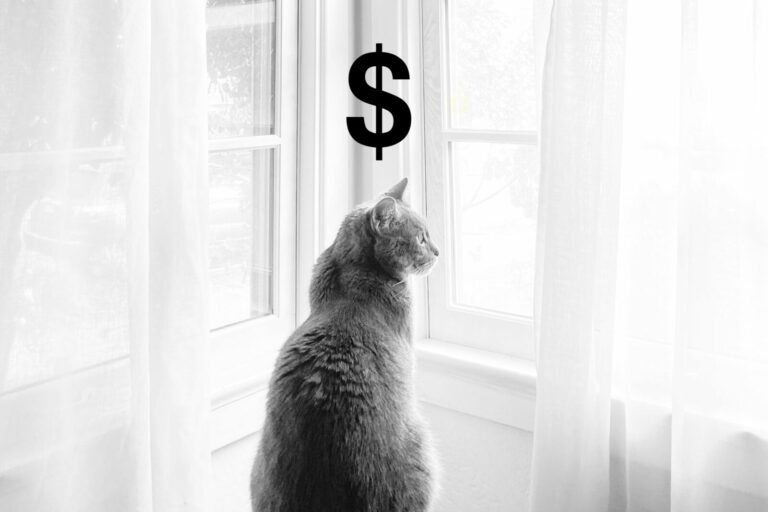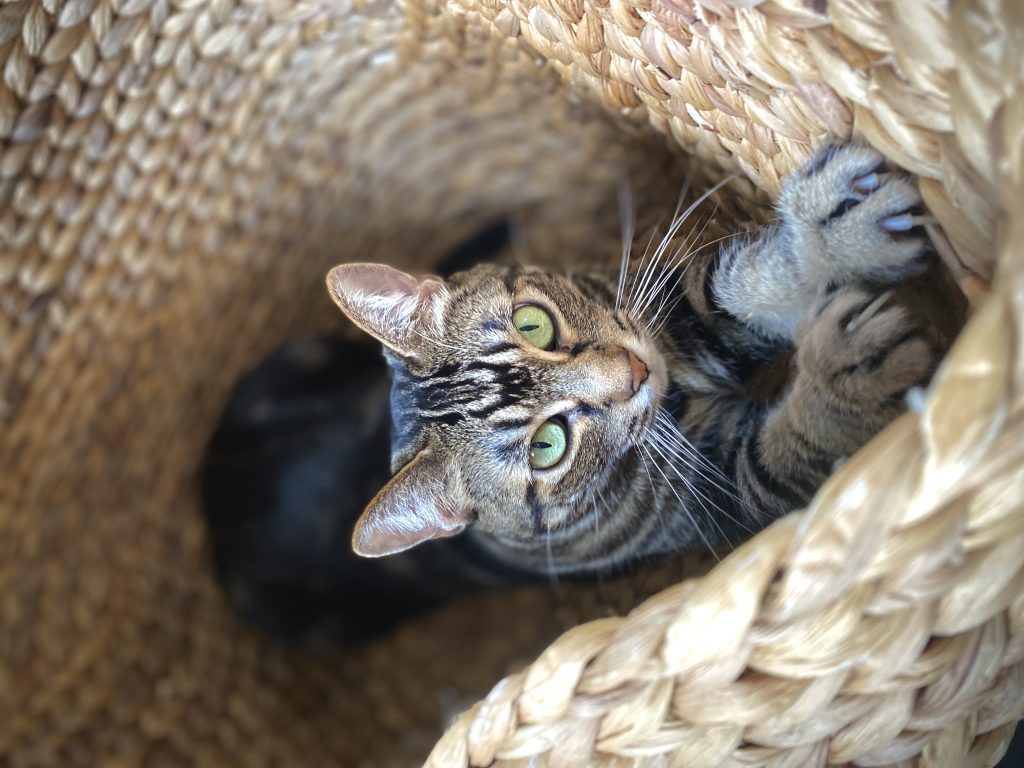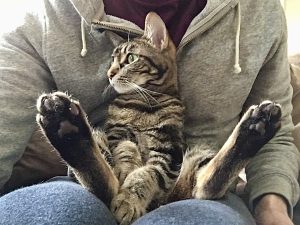Cat Owner’s Guide to Budgeting
If you’re thinking about getting a cat, you are wise to be reading up on how much it will actually cost. This article breaks down everything you need to know to help you decide whether you can afford to have a cat.

How much does it cost to have a cat? It can vary widely due to a range of factors.
At a minimum, you should expect to pay at least $400 up front to get started in your first month with your new cat. After that, the primary expenses include food, litter, and wellness vet visits, along with an array of other things like toys and scratching posts. The ongoing cost of having one cat is between $650 and $1600 per year.
There are also many other possible expenses that will vary according to your own preferences as well as your cat’s individual needs.
We’ll talk about the up-front costs for getting a cat first, then dive into the ongoing expenses involved in cat ownership.
Up Front, One-Time Costs to Get Started
Adoption Fees and Vet Visits
Getting started with a new cat typically costs at least $300 or $400, though the cost varies depending on where you get your cat from.
When you adopt a cat, the largest expenses to get started will be the adoption fee and initial vet visit for vaccinations, spay/neutering, and microchipping.
Many adoption agencies will have already completed those pieces of the vet care and may pass those costs on to you in the adoption fee. If those things haven’t been done yet, the adoption fee may be smaller and you’ll be required to obtain those vet services separately.
Adoption fees can be much higher if you buy from a breeder, and they depend on your location and the type of breed. Cats from breeders can range from $500 to as much as $2500 or more.
We always strongly encourage those thinking about getting a cat to consider adopting from shelters and rescue agencies. If you’re curious about options from breeders, be sure to read up on the ethics of cat breeding.
Basic Supplies Needed Before You Get a Cat
In addition to the adoption fees and initial veterinary care, you will also need to purchase a number of basic supplies before the big day comes when you bring your new cat home. You can improvise for a few things, like food/water bowls and toys.
Breakdown of the Essentials
| Low-End Budget | Higher-End Budget | |
|---|---|---|
| Pet Carrier | $30 | $85 |
| Litter Box | $10 | $100 |
| First Month’s Litter | $10 | $30 |
| Food and Water Bowls | $0 | $30 |
| First Month’s Cat Food | $20 | $50 |
| Toys | $0 | $30 |
| Cat Bed | $10 | $30 |
| Cat Climber | $30 | $200 |
| Scratchers | $10 | $50 |
| Claw Trimmers | $5 | $15 |
| Grooming Brush | $5 | $20 |
| Total | $130 | $640+ |
If you’re looking to splurge on your new furry pal, there is certainly no shortage of stuff you can buy for a cat in every imaginable category.
Ongoing Expenses
Here is roughly what you can expect as an ongoing annual budget for one cat. Food and litter are consistent expenses over time. So is pet insurance if you choose to insure your cat.
Vet bills can vary a lot depending on the health of your cat, your vet’s rate, any emergencies or health issues that come up, whether you have insurance, and the vaccinations that are due in a given year.
Ongoing Annual Expenses for Having One Cat
| Low-end Annual Budget | High-end Annual Budget | |
|---|---|---|
| Food | $300 | $800+ |
| Litter | $160 | $250 |
| Treats | $30 | $150 |
| Toys | $10 | $50 |
| Scratchers & Other Supplies | $30 | $150 |
| Vet Care & Vaccines | $200 | $600 |
| Total | $730 | $2,000+ |
If you have more than one cat, some of the cost-per-cat expenses will probably be lower (e.g., shared toys and furniture).
Additional Ongoing Expenses that May or May Not Apply to You
These will depend on your preferences, budget, and self-discipline, as well as individual circumstances of you and your cat.
Insurance
If you choose to carry insurance, that annual cost ranges from around $150 to over $400, depending on the carrier, what your chosen plan covers, and where you live. It may sound like a lot, but for many people it’s worth it just for the peace of mind.
And of course if something expensive were to happen, you could end up saving a lot of money and be able to help treat your cat without the additional financial stress that unexpected and expensive injuries or illnesses can lead to.
Keep in mind that outdoor cats have much higher rates of injury, illness, and life-threatening incidents compared to cats who stay indoors.
Flea and Parasite Treatment
If you have the misfortune of a cat with fleas, there will be a cost to treating the problem. The more proactive you are in dealing with fleas, the more easily you’ll be able to keep them in check.
If you ignore the problem, you will probably have not only a cat with fleas, but a house with fleas, as well.
Trust me, you really don’t want that. They can be very difficult (and expensive) to get rid of once they’re established. In fact, I’m dealing with an infestation as I write this.
If you let your cat go outside, you are much more likely to have to deal with fleas, so factor that into your budget accordingly.
It is also very common for a kitten or cat to have fleas at the time they are adopted. Make sure you check this at your first vet visit, and tackle the problem right then if your kitty has them.
If you catch the problem right away and your home doesn’t become infested, then treatment can be a one-off expense. If the problem persists, or it is recurring because your cat goes outside and is regularly at risk of getting fleas, then the cost can be longer-term or an ongoing monthly expense.
If your cat does have fleas, you also need to make sure they don’t have tapeworms, which they can develop as a result of having fleas (another reason you want to be proactive about fleas).
Costs to get rid of fleas
It’s hard to give an estimate for what it would cost, because it will depend a lot on how bad your problem is and how stubborn it is to treat it.
If you’re lucky enough to have a one-off expense and be rid of fleas quickly, the costs will likely be in the range of $100-$300.
If you have an infestation, it will require more time and cost to address the problem, potentially costing a few hundred to well over $1,000.
In short, in order to get rid of fleas, you need to properly clean your house, in addition to treating your cat, so that the problem doesn’t come back or spiral out of control.
Opportunities to splurge are seemingly endless
Yep, people love to spend on their pets, and cats are no exception. Indeed, the sky’s the limit when it comes to ways you can splurge on stuff for your cat.
There’s high end food, a huge variety of toys, tech for monitoring and tracking your cat, pet portrait photographers, supplements, and even overpriced auto-cleaning litter boxes.
But the opportunities for splurging may be most apparent when it comes to the wonderful world of cat furniture and options for creating cat-friendly spaces in your home.
These include:
- Condos, climbers, and trees ($30 to several hundred dollars and up)
- window perches and boxes ($30 to several hundred dollars)
- wall installations ($35 to several hundred dollars)
- and even catios (hundreds to thousands of dollars, with lots of fun DIY options)
All of this to warn you that it may take some self-discipline to keep from splurging on your cat in ways that blow your budget. But in my opinion, it’s also super fun to splurge in this way if you can afford it or have some DIY energy.
Pet Sitting for When You’re Gone
If you’re ever gone from home for more than one short night, you’ll need to arrange for someone to take care of your cat. I am usually lucky enough to be able to do this for free, because I have awesome family and friends who are willing to help out when I’m away. And I do the same for their pets when they leave town.
If you don’t have family, friends, or housemates who are available to help, you will need to arrange for someone to come to your home twice per day, or take your cat to a boarding service. This can be a great gig for a responsible teenager in your neighborhood.
While there are good quality boarding options in many places, this is the least desirable solution because of the stress it places on the cat.
That said, you can budget for $20-$30 per day on the low end for cat care while you’re gone.
Affiliate Disclosure: VerveCat is supported by readers. As a member of Amazon Associates and other affiliate programs, we may earn a commission at no added cost to you when you follow a product link and make a purchase.
My Own Set-Up For Reference
In addition to the cost estimates provided above, I’ve also included what I use personally for my own furrocious fuzz butts. Where applicable, I have included a link to the actual product I am using.
| Item | What I currently use |
|---|---|
| Litter Box | Iris Round Top Entry (Amazon) and this cheaper Iris Top Entry model (Amazon) |
| Cat Carrier | Sherpa Original Deluxe (Amazon) |
| Food & Water Bowls | Van Ness Pets Stainless Steel (Amazon) |
| Litter | Dr. Elsey’s Precious Cat Ultra Unscented 40lb Bag (Amazon) |
| Food | Wellness Tall Cans (Amazon), occasional Open Farm wet and dry foods, and a wide variety of Weruva (Amazon) wet food |
| Toys | Too many, and a lot of DIY. Phoebe’s favorite is an old, ratty piece of rope. |
| Cat Tree | Carpeted Double Decker from my local Feed Store |
| Bed | My DIY bed is a shallow basket from Ikea lined with a fleece blanket from Target. I also have a Meowfia Felt Cat Cave (Amazon) that Bean and Phoebe love |
| Scratch | Multiple Frisco Cardboard Scratchers from Chewy and a PetFusion 3-Sided Vertical (Amazon) scratcher |
Someday I hope to design and build a nice catio, or at least a nice condo enclosure that attaches over the window on the outside of the house.
For now though, I have a mudroom/entryway that is a designated cat space. It has a cat tree with built-in cat beds, a food/water area, litterbox, and the option to close them in each night or keep them separate from the mix of guests during a gathering when doors to the outside are opened frequently.
So can you afford to get a cat?
Now that you have a good understanding of the kind of budget that’s necessary for having a cat, you are closer to being able to make an informed decision about whether or not to get one.
Again, you should only get a cat if you know you can afford it and are able to make the long-term commitment. There’s a lot more than cost to consider before deciding to add a cat to your home.

